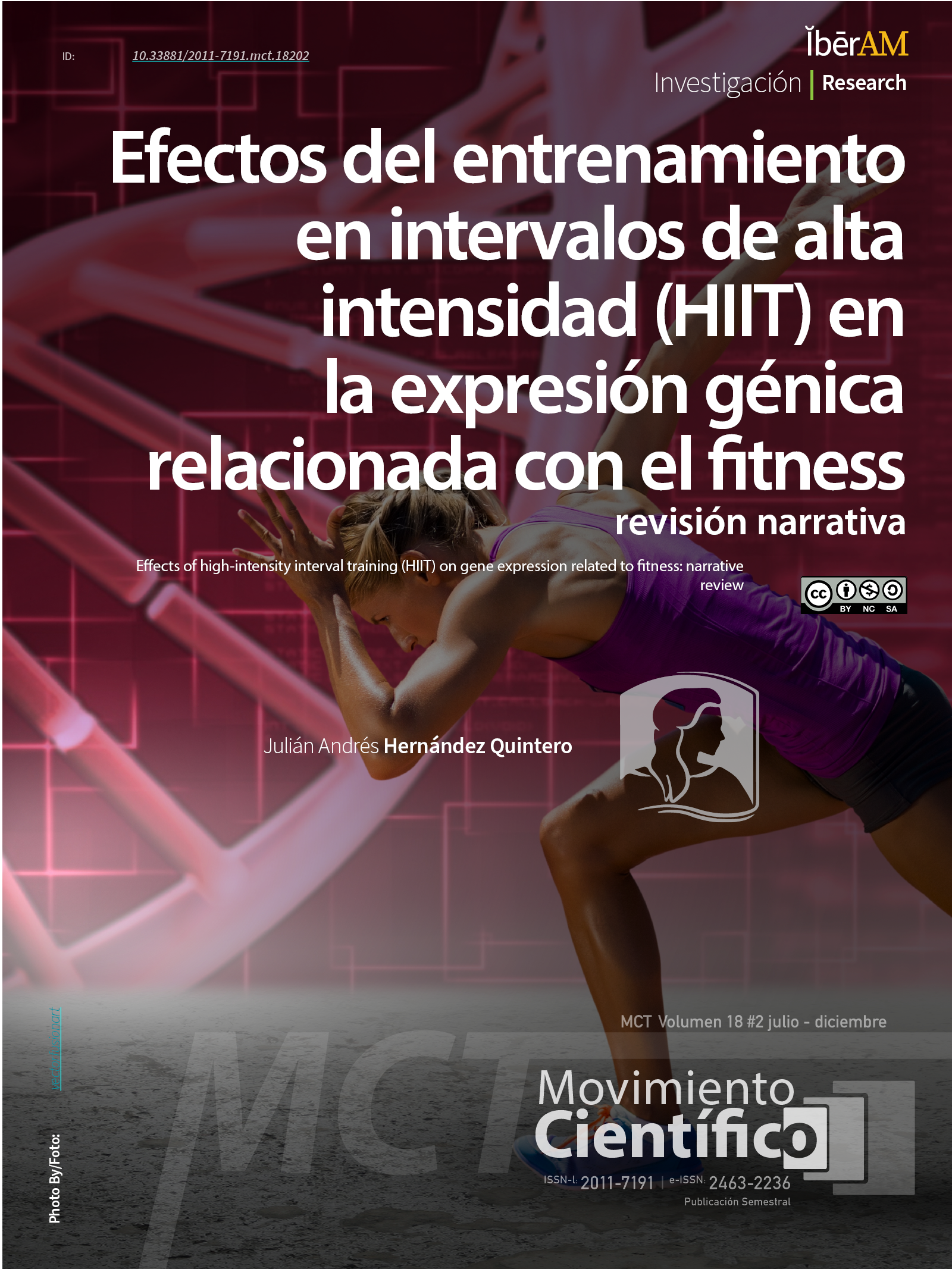Efectos del entrenamiento en intervalos de alta intensidad (HIIT) en la expresión génica relacionada con el fitness
Effects of high-intensity interval training (HIIT) on gene expression related to fitness Revisión narrativa
Contenido principal del artículo
El entrenamiento en intervalos de alta intensidad (HIIT) ha emergido como una estrategia efectiva para mejorar la aptitud física y modular procesos metabólicos y moleculares clave. Este estudio tiene como objetivo analizar los efectos del HIIT sobre la expresión génica relacionada con el fitness, enfocándose en vías como la biogénesis mitocondrial, la angiogénesis, el metabolismo energético, la inflamación y la respuesta inmune. Método: Se realizó una revisión narrativa de 14 estudios relevantes, seleccionados tras una búsqueda exhaustiva en PubMed utilizando términos como "HIIT", "expresión génica", "biogénesis mitocondrial" y "angiogénesis". Los estudios incluidos abarcan ensayos clínicos, estudios observacionales y estudios en modelos animales que investigaron el impacto del HIIT en la expresión génica. Los datos extraídos incluyeron el tipo de estudio, protocolo de HIIT, características de la población, métodos de evaluación de la expresión génica y resultados principales. Resultados: Los estudios revisados muestran que el HIIT induce cambios significativos en genes clave como PGC-1α, VEGF, eNOS, IL-6 y diversos miRNAs, lo que mejora la biogénesis mitocondrial, la angiogénesis, el metabolismo energético y la respuesta inmune. Las variaciones en los protocolos de HIIT influyen en la magnitud de estas adaptaciones moleculares. Conclusión: El HIIT es una intervención eficaz para mejorar la aptitud física y modular vías genéticas clave, ofreciendo beneficios potenciales para diversas poblaciones, incluidas aquellas con enfermedades crónicas y adultos mayores sedentarios. La personalización de los protocolos de HIIT puede maximizar estos efectos positivos.
Descargas
Datos de publicación
Perfil evaluadores/as N/D
Declaraciones de autoría
Indexado en
-
—
- Sociedad académica
- N/D
- Editorial
- Bogotá: Corporación Universitaria Iberoamericana
Detalles del artículo
Alihemmati, A., Ebadi, F., Moghadaszadeh, M., Asadi, M., Zare, P., & Badalzadeh, R. (2019). Effects of high-intensity interval training on the expression of microRNA-499 and pro- and anti-apoptotic genes in doxorubicin-cardiotoxicity in rats. Journal of Electrocardiology, 55, 9–15. https://doi.org/10.1016/J.JELECTROCARD.2019.02.009 DOI: https://doi.org/10.1016/j.jelectrocard.2019.02.009
Andonian, B. J., Johannemann, A., Hubal, M. J., Pober, D. M., Koss, A., Kraus, W. E., Bartlett, D. B., & Huffman, K. M. (2021). Altered skeletal muscle metabolic pathways, age, systemic inflammation, and low cardiorespiratory fitness associate with improvements in disease activity following high-intensity interval training in persons with rheumatoid arthritis. Arthritis Research & Therapy, 23(1). https://doi.org/10.1186/S13075-021-02570-3 DOI: https://doi.org/10.1186/s13075-021-02570-3
Andonian, B. J., Koss, A., Koves, T. R., Hauser, E. R., Hubal, M. J., Pober, D. M., Lord, J. M., MacIver, N. J., St Clair, E. W., Muoio, D. M., Kraus, W. E., Bartlett, D. B., & Huffman, K. M. (2022). Rheumatoid arthritis T cell and muscle oxidative metabolism associate with exercise-induced changes in cardiorespiratory fitness. Scientific Reports, 12(1). https://doi.org/10.1038/S41598-022-11458-4 DOI: https://doi.org/10.1038/s41598-022-11458-4
Bishop, D. J., Botella, J., Genders, A. J., Lee, M. J.-C., Saner, N. J., Kuang, J., Yan, X., & Granata, C. (2019). High-Intensity Exercise and Mitochondrial Biogenesis: Current Controversies and Future Research Directions. Physiology, 34(1), 56–70. https://doi.org/10.1152/physiol.00038.2018 DOI: https://doi.org/10.1152/physiol.00038.2018
Castro, V., Grisdale-Helland, B., Jørgensen, S. M., Helgerud, J., Claireaux, G., Farrell, A. P., Krasnov, A., Helland, S. J., & Takle, H. (2013). Disease resistance is related to inherent swimming performance in Atlantic salmon. BMC Physiology, 13(1). https://doi.org/10.1186/1472-6793-13-1 DOI: https://doi.org/10.1186/1472-6793-13-1
Cobley, J. N., Bartlett, J. D., Kayani, A., Murray, S. W., Louhelainen, J., Donovan, T., Waldron, S., Gregson, W., Burniston, J. G., Morton, J. P., & Close, G. L. (2012). PGC-1α transcriptional response and mitochondrial adaptation to acute exercise is maintained in skeletal muscle of sedentary elderly males. Biogerontology, 13(6), 621–631. https://doi.org/10.1007/s10522-012-9408-1 DOI: https://doi.org/10.1007/s10522-012-9408-1
Denham, J., Gray, A. J., Scott-Hamilton, J., Hagstrom, A. D., & Murphy, A. J. (2018). Small non-coding RNAs are altered by short-term sprint interval training in men. Physiological Reports, 6(7). https://doi.org/10.14814/phy2.13653 DOI: https://doi.org/10.14814/phy2.13653
Gorzi, A., Jafari, F., Allahmoradi, N., Rahmani, A., & Krause Neto, W. (2021). Training Intensity, Not Duration, May Be Key to Upregulating Presynaptic Proteins of Calcium Dynamics and Calcium-Dependent Exocytosis in Fast- and Slow-Twitch Skeletal Muscles, in Addition to Maintaining Performance After Detraining. Molecular Neurobiology, 58(12), 6670–6683. https://doi.org/10.1007/s12035-021-02576-7 DOI: https://doi.org/10.1007/s12035-021-02576-7
Kumar Dev, P., Gray, A. J., Scott-Hamilton, J., Hagstrom, A. D., Murphy, A., & Denham, J. (2021). Co-expression analysis identifies networks of miRNAs implicated in biological ageing and modulated by short-term interval training. Mechanisms of Ageing and Development, 199. https://doi.org/10.1016/j.mad.2021.111552 DOI: https://doi.org/10.1016/j.mad.2021.111552
Lionett, S., Kiel, I. A., Camera, D. M., Vanky, E., Parr, E. B., Lydersen, S., Hawley, J. A., & Moholdt, T. (2020). Circulating and Adipose Tissue miRNAs in Women With Polycystic Ovary Syndrome and Responses to High-Intensity Interval Training. Frontiers in Physiology, 11, 904. https://doi.org/10.3389/fphys.2020.00904 DOI: https://doi.org/10.3389/fphys.2020.00904
Luo, L., Liu, M., Xie, H., Fan, Y., Zhang, J., Liu, L., Li, Y., Zhang, Q., Wu, J., Jiang, C., & Wu, Y. (2021). High-Intensity Interval Training Improves Physical Function, Prevents Muscle Loss, and Modulates Macrophage-Mediated Inflammation in Skeletal Muscle of Cerebral Ischemic Mice. Mediators of Inflammation, 2021. https://doi.org/10.1155/2021/1849428 DOI: https://doi.org/10.1155/2021/1849428
Niño Méndez, Ó. A., Reina-Monroy, J. L., Ayala Pedraza, G., Portilla-Melo, J. G., Aguilar-Romero, I. D., Núñez-Espinosa, C. A., & Rodríguez-Mora, J. L. (2021). Efectos del entrenamiento de intervalos de alta intensidad en altitud simulada. Revista de Investigación e Innovación en Ciencias de la Salud, 3(1), 98-115. https://doi.org/10.46634/riics.50 DOI: https://doi.org/10.46634/riics.50
Miyamoto-Mikami, E., Tsuji, K., Horii, N., Hasegawa, N., Fujie, S., Homma, T., Uchida, M., Hamaoka, T., Kanehisa, H., Tabata, I., & Iemitsu, M. (2018). Gene expression profile of muscle adaptation to high-intensity intermittent exercise training in young men. Scientific Reports, 8(1). https://doi.org/10.1038/s41598-018-35115-x DOI: https://doi.org/10.1038/s41598-018-35115-x
Moris, R., Delgado-Floody, P., & Martínez-Salazar, C. (2020). El entrenamiento intervalado de alta intensidad incrementa la utilización de ácidos grasos en sujetos con sobrepeso u obesidad. Nutrición Hospitalaria, 37(3), 483-489. https://doi.org/10.20960/nh.02940
Plaza-Diaz, J., Izquierdo, D., Torres-Martos, Á., Baig, A. T., Aguilera, C. M., & Ruiz-Ojeda, F. J. (2022). Impact of Physical Activity and Exercise on the Epigenome in Skeletal Muscle and Effects on Systemic Metabolism. Biomedicines, 10(1). https://doi.org/10.3390/biomedicines10010126 DOI: https://doi.org/10.3390/biomedicines10010126
Robinson, M. M., Dasari, S., Konopka, A. R., Johnson, M. L., Manjunatha, S., Esponda, R. R., Carter, R. E., Lanza, I. R., & Nair, K. S. (2017). Enhanced Protein Translation Underlies Improved Metabolic and Physical Adaptations to Different Exercise Training Modes in Young and Old Humans. Cell Metabolism, 25(3), 581–592. https://doi.org/10.1016/j.cmet.2017.02.009 DOI: https://doi.org/10.1016/j.cmet.2017.02.009
Rundqvist, H., Augsten, M., Strömberg, A., Rullman, E., Mijwel, S., Kharaziha, P., Panaretakis, T., Gustafsson, T., & Östman, A. (2013). Effect of Acute Exercise on Prostate Cancer Cell Growth. PLoS ONE, 8(7), e67579. https://doi.org/10.1371/journal.pone.0067579 DOI: https://doi.org/10.1371/journal.pone.0067579
Scott, S. N., Shepherd, S. O., Hopkins, N., Dawson, E. A., Strauss, J. A., Wright, D. J., Cooper, R. G., Kumar, P., Wagenmakers, A. J. M., & Cocks, M. (2019). Home-hit improves muscle capillarisation and eNOS/NAD(P)Hoxidase protein ratio in obese individuals with elevated cardiovascular disease risk. The Journal of Physiology, 597(16), 4203–4225. https://doi.org/10.1113/JP278062 DOI: https://doi.org/10.1113/JP278062
Tomescu, A. I., Kuosmanen, A., Rizzi, R., & Mäkinen, V. (2013). A novel min-cost flow method for estimating transcript expression with RNA-Seq. BMC Bioinformatics, 14(SUPPL.5). https://doi.org/10.1186/1471-2105-14-S5-S15 DOI: https://doi.org/10.1186/1471-2105-14-S5-S15
Torma, F., Gombos, Z., Jokai, M., Takeda, M., Mimura, T., & Radak, Z. (2019). High intensity interval training and molecular adaptive response of skeletal muscle. Sports Medicine and Health Science, 1(1), 24–32. https://doi.org/10.1016/j.smhs.2019.08.003 DOI: https://doi.org/10.1016/j.smhs.2019.08.003
Tsuchiya, Y., Takakura, H., Osawa, S., & Izawa, T. (2023). Impact of high-intensity interval training on tendon related gene expression in rat Achilles tendon. Biochemical and Biophysical Research Communications, 658, 116–121. https://doi.org/10.1016/J.BBRC.2023.03.076 DOI: https://doi.org/10.1016/j.bbrc.2023.03.076
Vardar, S. A., Doganlar, Z. B., Kaya, O., Tayfur, P., Sut, N., & Doganlar, O. (2021). Different responses of apoptotic, inflammatory and heat shock protein gene expression to a single bout of high-intensity interval exercise between physically active and inactive men. Applied Physiology, Nutrition and Metabolism, 46(7), 743–752. https://doi.org/10.1139/apnm-2020-0783 DOI: https://doi.org/10.1139/apnm-2020-0783
Zhang, J., Wallace, S. J., Shiu, M. Y., Smith, I., Rhind, S. G., & Langlois, V. S. (2017). Human hair follicle transcriptome profiling: A minimally invasive tool to assess molecular adaptations upon low-volume, high-intensity interval training. Physiological Reports, 5(23). https://doi.org/10.14814/phy2.13534 DOI: https://doi.org/10.14814/phy2.13534















